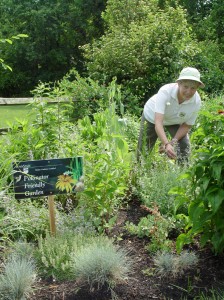What Goes Where?
June 14th, 2011
One thing that makes a Master Gardener a master gardener is knowing what plants will work where.
That was pretty apparent from the Cumberland County Master Gardeners’ home gardens on this year’s third annual “At Home in the Garden” tour.
I got to see five of the seven of them on Sunday, sandwiched around that inch-and-a-half dumping we got in a half-hour.
A big hindrance for mere mortal gardeners is not knowing plants very well. And so a lot of people buy what they like and plant them wherever they look good.
That works sometime. But most plants are at least a little picky about what kind of sun, drainage and space they’re given.
Guess wrong and they’ll let you know by getting bugs, disease or no flowers. Or they’ll just croak.
Garden-making is a lot trickier than home decorating.
Penn State-trained Master Gardeners have figured that out. They pay close attention to each part of their yard and then go looking for the best plants suited to the conditions there. (Most of the time, anyway.)
When they still guess wrong, they’re confident enough to move the plants until they find the perfect spot.
Larry Lenig, a Master Gardener from Hampden Twp., says he suspects he’s moved every plant in his yard three or four times over the years.
I especially liked Larry’s back yard. He left a rectangle of brick-edged lawn in the middle but turned all three back-yard borders into beautifully layered gardens of mixed shrubs, perennials and groundcovers.
These stone-edged border beds come out close to 25 feet.
That kind of bed width — which few people bite off — gives space for four to five layers of plants.
That makes it possible to use enough plants so there’s always something in bloom and plenty of variation in forms and textures.
“It’s kind of a cross between Williamsburg and an English cottage garden,” is how Larry describes it.
The variety makes for a dynamic garden that never looks the same for long.
“Every 3 weeks it changes,” Larry says.
Few people pull off this kind of full, vibrant and consistently colorful look, mainly because their beds are small and their selection limited to a handful of varieties.
Larry milks the most out of his beds by spotting varieties throughout (as opposed to massing all of each plant in one area) and by using perennials with colorful foliage.
All five gardens I saw were exceptionally healthy — in large part because of right plants in right places.
Mary Carson’s Creekside garden in Camp Hill was mostly wet and in full to part shade.
That’s a recipe of death for a lot of plants, but Mary sidestepped carnage by gravitating to damp shade plants such as great blue lobelia, sedges, turtlehead, yellow-flag iris, buttonbush and winterberry holly.
On the other hand, Evan Jenkins’ front-yard garden in Hampden Twp. is bone dry from the roots of a big shade tree.
Mary’s plants would struggle there, but Evan knew he’d have much better odds by going with Russian cypress, liriope and barrenwort.
Both Evan and Maryann Skubecz of Hampden Twp. have yards that are certified under the new Master Gardener program “Pollinator Friendly Gardens.”
These are gardens designed to be helpful instead of deadly to bee and pollinating insects (no insecticides, plenty of nectar and pollen plants, one or more water sources and effort to eliminate non-native invasive plants).
If you’re interested in more about that program and protecting pollinators in general, my Patriot-News garden column coming up on June 30 will focus on this topic. In the meantime, visit online at http://ento.psu.edu/pollinators/public-outreach/cert.
The last Master Gardener garden I saw was Henry Line’s yard near the West Shore Country Club.
This yard reminded me most of my own yard — lawn paths through a network of curved garden beds filled with a gazillion or so different plants.
I especially liked the cutout Henry made for a bench in the middle of the side yard by installing a stone wall and raising the beds behind it.
Some cool stuff is growing in this garden — a dwarf cryptomeria, a katsura tree, a ‘Bracken’s Brown Beauty’ magnolia, an American fringe tree, a fruiting fig and much more.
It was sure a lot more interesting than a half-acre of grass with five azaleas and a maple tree.
Henry says he believes grass is good for getting from one place in the yard to another and that’s about it.
“Grass is the biggest weed in central Pennsylvania,” he says.
Now there’s a kindred spirit…










